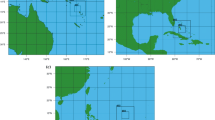Abstract
In the first paper in this series, a variational data assimilation of ideal tropical cyclone (TC) tracks was performed for the statistical-dynamical prediction model SD-90 by the adjoint method, and a prediction of TC tracks was made with good accuracy for tracks containing no sharp turns. In the present paper, the cases of real TC tracks are studied. Due to the complexity of TC motion, attention is paid to the diagnostic research of TC motion. First, five TC tracks are studied. Using the data of each entire TC track, by the adjoint method, five TC tracks are fitted well, and the forces acting on the TCs are retrieved. For a given TC, the distribution of the resultant of the retrieved force and Coriolis force well matches the corresponding TC track, i.e., when a TC turns, the resultant of the retrieved force and Coriolis force acts as a centripetal force, which means that the TC indeed moves like a particle; in particular, for TC 9911, the clockwise looping motion is also fitted well. And the distribution of the resultant appears to be periodic in some cases. Then, the present method is carried out for a portion of the track data for TC 9804, which indicates that when the amount of data for a TC track is sufficient, the algorithm is stable. And finally, the same algorithm is implemented for TCs with a double-eyewall structure, namely Bilis (2000) and Winnie (1997), and the results prove the applicability of the algorithm to TCs with complicated mesoscale structures if the TC track data are obtained every three hours.
Similar content being viewed by others
References
Chan, J. C. L., 2005: The physics of tropical cyclone motion. Annual Review of Fluid Mechanics, 37, 99–128.
Chan, J. C. L, and R. T. Williams, 1987: Analytical and numerical studies of the beta-effect in tropical cyclone motion. Part I: Zero mean flow. J. Atmos. Sci. 44, 1257–1265.
Chen Lianshou, and Ding Yihui, 1979: The Western Pacific Typhoon Conspectus. China Science Press, 491pp. (in Chinese)
Fiorino, M., and R. T. Elsberry, 1987: Some aspects of vortex structure related to tropical cyclone motion. J. Atmos. Sci., 46, 975–990.
Hodanish, Stephen, and William M. Gray, 1993: An observational analysis of tropical cyclone recurvature. Mon. Wea. Rev., 121, 2665–2689.
Huang Sixun, Han Wei, and Wu Rongsheng, 2004: Theoretical analyses and numerical experiments of variational assimilation for one-dimensional ocean temperature model with techniques in inverse problems. Science in China (D), 47(7), 630–638.
Huang Sixun, and Wu Rongsheng, 2001: Methods of Mathematical Physics in Atmospheric Science. China Meteorologica Press, 540pp. (in Chinese)
Kuo, H. L., 1969: Motions of vortices and circulating cylinder in shear flow with friction. J. Atmos. Sci., 26, 390–398.
Li Tianming, and Zhu Yongti, 1990: Analysis and modelling of tropical cyclone motions. I. The axisymmetric structure and the sudden change of tracks. Science in China (B), 34, 104–112. (in Chinese)
Luo Zhexian, 1991: Possible causes of counterclockwise loop of tropical cyclones. Science in China (B), 35, 769–775. (in Chinese)
Peng Jiayi, Fang Juan, and Wu Rongsheng, 2004: The formation mechanism of concentric double eyewall typhoon. Part I: Dynamical analysis. Acta Meteorologica Sinica, 18, 301–312.
Smith, R. K., 1991: An analytic theory of tropical cyclone motion in a barotropic shear flow. Quart. J. Roy. Meteor. Soc., 117, 685–714.
Willoughby, H. E., 1992: Linear motion of a shallow-water barotropic vortex as an initial value problem. J. Atmos. Sci., 49, 2015–2031.
Wu, C. C., and Emanuel K. A., 1993: Interaction of a baroclinic vortex with background shear: Application to hurricane movement. J. Atmos. Sci., 50, 62–76.
Wu, L. G., and B. Wang, 2000: A potential vorticity tendency diagnostic approach for tropical cyclone motion. Mon. Wea. Rev., 128, 1899–1911.
Xiang Jie, Wu Rongsheng, and Huang Sixun, 2004: Studies on application of the adjoint method to the statistic-dynamical prediction model for tropical cyclones (SD-90). I: Theoretical aspects and numerical tests. Progress in Natural Sciences, 14, 677–682. (in Chinese)
Xiang Jie, and Wu Rongsheng, 2005: The effects of asymmetric wind structures of tropical cyclones on their tracks. Acta Meteorologica Sinica, 19, 52–59.
Xue Zongyuan, and Li Zufeng, 1995: The statistic-dynamical prediction scheme for the tracks of tropical cyclones in the Northwest Pacific and the operational test results. Atmospheric Science Research and Applications, 5, 59–65. (in Chinese)
Yeh, T. C., 1950: The motion of tropical storms under the influence of a superimposed southerly current. Journal of Meteorlogy, 7, 108–113.
Zhu, T., D.-L. Zhang, and F. Weng, 2004: Numerical simulation of Hurricane Bonnie (1998). Part I: Eyewall evolution and intensity changes. Mon. Wea. Rev., 132, 225–241.
Author information
Authors and Affiliations
Rights and permissions
About this article
Cite this article
Xiang, J., Liao, Q., Huang, S. et al. An application of the adjoint method to a statistical-dynamical tropical-cyclone prediction model (SD-90) II: Real tropical cyclone cases. Adv. Atmos. Sci. 23, 118–126 (2006). https://doi.org/10.1007/s00376-006-0012-7
Received:
Revised:
Issue Date:
DOI: https://doi.org/10.1007/s00376-006-0012-7




